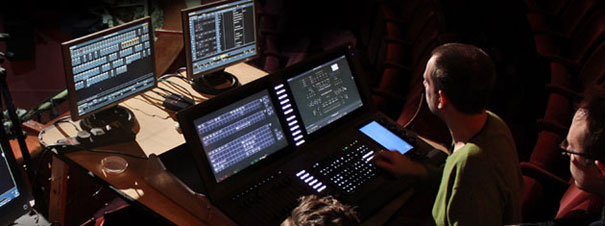ETC Eos Ti™ starts new trend on the West End
Date Posted: 5/15/2014

There's a new workhorse gaining popularity behind the scenes on the West End. ETC's
Eos Titanium (Ti)
lighting control system has been taking over the programming duties on a growing number of London's top shows, with more lighting professionals choosing the power and flexibility that the desk offers. Two of those professionals - Vicky Brennan and Andi Davis - share their experience with Ti and why they trust it on even the biggest shows.
Brennan recently programmed the lighting for
Stephen Ward: The Musical
at the Aldwych Theatre on a Ti desk. The show's set was incredibly complicated and required custom circular lighting trusses for the lighting fixtures. That created a challenge for the lighting team, who had to devise a plan to number the rig so the lighting designer, programmer, production electricians and show crew could all understand it. Ti's Magic Sheets function was the answer. "Being able to dispense with a large and cumbersome paper plan and not needing to have a laptop nearby with the plan open on it, meant that I had the information literally at my fingertips," describes Brennan. "Using Ti's multi-touch screens meant that I could pinch and pull the plan to focus in on the useful areas to ascertain the relevant channel information."
The set design included several curtains used like scrims throughout the show, sometimes serving as a wall and other times as a window. As the curtains were moved along tracks for different scenes, lighting designer Peter Mumford wanted to follow their paths with par-can lighting, which meant a complex formula of timing, speed and direction. "Once again, the Magic Sheets became a useful tool, as we could keep track of changes to the lights in real time without needing to consistently plunge the stage into darkness," explains Brennan. "Maintenance could be happening to the rig and we could play back the timings and journey of the lights on the Magic Sheet of the rig."
The Magic Sheets also simplified the transition of the show from Brennan's team to the Aldwych Theatre's house crew. While
Stephen Ward
was on the West End, it was run off an ETC Eos® console with a backup
Ion®
desk, and the lighting staff was able to use the Magic Sheets for troubleshooting, without having to rely on a paper plan as they would have in the past.
Stephen Ward
's lighting rig included moving lights, LEDs and conventionals rented from ETC dealer PRG. Some of the fixtures were new to some of the staff, but Ti's troubleshooting allowed the in-house staff the ability to identify issues and remedy them very quickly. Says Brennan: "Because of the way that the desk handles fixtures, using real-world values in terms of degrees of movement, size and angle of indexing for shutters and gobos, I was able to deal with a variety of fixtures from different manufacturers with a high level of familiarity across the rig."
Like Brennan, Davis has also gained a lot of experience on Ti since its introduction in 2013. Some of the shows he's done with it are
Dirty Rotten Scoundrels, The Pajama Game, The Ladykillers, Dirty Dancing
, and the Olivier-Award-winning
Jeeves and Wooster
. "I've been using Ti on pretty much everything I've done over the last year," he says. "The big difference with Ti is that it feels like a really luxurious experience. At every stage you get more of everything - more processing power, more user-definable keys, more output capacity, and in particular, more screen real-estate with the two enormous, high-resolution touchscreens."
Most of the shows Davis works on include massive mixed rigs that require a lot of data handling over the course of a long production period. That's when Ti is the most useful. "Ti is extremely enjoyable to use, because it has so much screen space available," describes Davis. "It makes managing large rigs - with the inevitable large number of presets and palettes that they entail - incredibly easy."
Ti's ability to control such a complex lighting-design proved indispensable on
Dirty Rotten Scoundrels
. Set and costume designer Peter McKintosh designed a printed backdrop that was lit from behind by a wall of LED panels. Lighting Designer Howard Harrison wanted to use the screen not just as a backlit cloth, but to experiment with color and texture as the show progressed. Davis was able to use Ti's Virtual Server feature, which is part of the Eos-family software, to devise color and content for the wall. "Eos Ti was ideally suited to this flexible approach, with the large, high-resolution screens making programming of pixel content a pleasure," says Davis.
Ti is just the latest Eos-family desk to find a home on the West End and on other big-name productions. As more designers get familiar with the console, and more rental companies add it to their stock, Ti's résumé will continue to expand. "Eos-family consoles are increasingly the most compelling choice on large-scale theater shows, because they offer the power to run complex, diverse rigs. The ETC brand and Eos consoles have a reputation for stability, great support and customer service. On large-scale, high-profile shows, that reputation is important. The lighting team needs to feel we're in safe hands. I think that designers, programmers and production electricians increasingly feel that Eos systems offer that assurance," summarizes Davis.